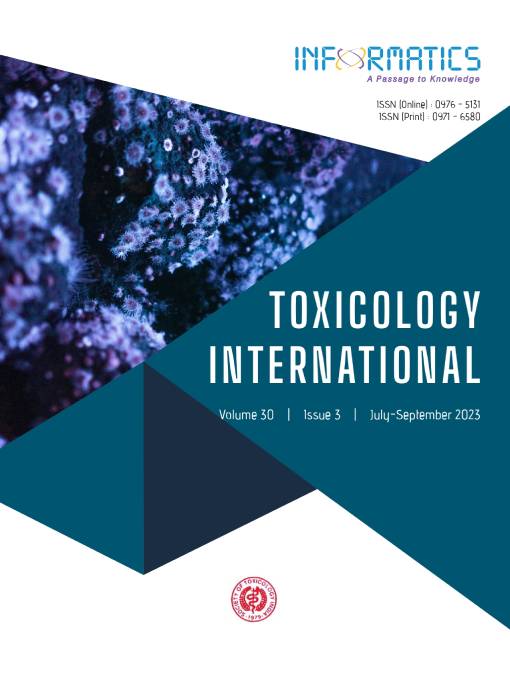Phytochemical Screening and Evaluation of Antioxidant and Antiproliferative Potential of Morus alba (L.) Leaves Extracts Against Breast Cancer Cell Lines
DOI:
https://doi.org/10.18311/ti/2023/v30i3/33811Keywords:
Antiproliferative Activity, Breast Cancer, Morus alba (L.), MTT (3-(4,5-dimethylthiazol-2-yl)-2,5-diphenyl tetrazolium bromide)Abstract
Morus alba (L.) belongs to the family Moraceae commonly known as white mulberry used in folk medicine in the remedy of dysentery, diuretic, and antidiabetic treatments. Morus species contain several bioactive compounds which attribute to their biological properties. The purpose of this study is to determine the total phenolic content, antioxidant potential and antiproliferative activity of different leaf extracts of Morus alba (L). The plant leaves extracts were prepared by the Soxhlet extraction method. The total phenolic content was determined by Folin–Ciocalteu method and antioxidative potential was assessed by H2O2 free radical scavenging assay. The antiproliferative potential was investigated by MTT (3-[4,5- dimethylthiazol-2-yl]-2,5 diphenyl tetrazolium bromide) assay using breast cancer cell lines MCF-7 and MDA-MB-231. Our results showed that all the extracts exhibited significant antioxidant and antiproliferative activity dose-dependently. Amongst all, the ethanolic leaf extract possessed higher radical scavenging activity as well as potent cytotoxicity against breast cancer cells. Furthermore, the ethanolic leaf extract was subjected to analyse of its bioactive composition that might be responsible for its potent antioxidant and antiproliferative potential. The presence of different functional groups in the extract was analysed by Fourier Transform Infrared (FTIR) technique and the main bioactive compounds in the extract were identified by Liquid Chromatography-Mass Spectrometry (LC-MS). Therefore, it can be concluded by the above findings that Morus alba (L.) has promising antioxidant activity and potent antiproliferative activity against breast cancer cells and thus can be used as a great source of natural antioxidants in developing drugs against various diseases.
Downloads
Published
How to Cite
Issue
Section
Accepted 2023-07-07
Published 2023-09-20
References
Giaquinto AN, Sung H, Miller KD, Kramer JL, Newman LA, Minihan A, et al. Breast cancer statistics. CA Cancer J Clin. 2022; 72(6):524-41. https://doi.org/10.3322/caac.21754 PMid:36190501. DOI: https://doi.org/10.3322/caac.21754
Hassan MSU, Ansari J, Spooner D, Hussain SA. Chemotherapy for breast cancer. Oncology Reports. 2010; 24(5):1121-31. PMID: 20878101. https://doi.org/10.3892/ or_00000963. DOI: https://doi.org/10.3892/or_00000963
Mitra S, Dash R. Natural products for the management and prevention of breast cancer. Evidence-Based Complementary and Alternative Medicine. 2018. https:// doi.org/10.1155/2018/8324696 PMid:29681985 PMCid: PMC5846366. DOI: https://doi.org/10.1155/2018/8324696
Somasundaram S, Edmund NA, Moore DT, Small GW, Shi YY, Orlowski RZ. Dietary curcumin inhibits chemotherapyinduced apoptosis in models of human breast cancer. Cancer research. 2002; 62(13):3868-75. PMID: 12097302.
Hasani-Ranjbar S, Larijani B, Abdollahi M. A systematic review of the potential herbal sources of future drugs effective in oxidant-related diseases. Inflam Allergy- Drug Targets. 2009;8(1):2-10. https://doi.org/10.2174/ 187152809787582561 PMid:19275687. DOI: https://doi.org/10.2174/187152809787582561
Mallhi TH, Qadir MI, Khan YH, Ali M. Hepatoprotective activity of aqueous methanolic extract of Morus nigra against paracetamol-induced hepatotoxicity in mice. Bangl J Pharmacol. 2014; 9(1):60-6. https://doi.org/10.3329/bjp. v9i1.17337. DOI: https://doi.org/10.3329/bjp.v9i1.17337
El-Hawary SS, Sayed AM, Issa MY, Ebrahim HS, Alaaeldin R, Elrehany MA, et al. Anti-Alzheimer chemical constituents of Morus macroura Miq: Chemical profiling, in silico and in vitro investigations. Food and Function. 2021; 12(17):8078- 89. https://doi.org/10.1039/D1FO01177D PMid:34286787. DOI: https://doi.org/10.1039/D1FO01177D
Slinkard K, Singleton VL. Total phenol analysis: Automation and comparison with manual methods. American Journal of Oenology and Viticulture. 1977; 28(1):49-55. https://doi. org/10.5344/ajev.1977.28.1.49. DOI: https://doi.org/10.5344/ajev.1974.28.1.49
Ruch RJ, Cheng SJ, Klaunig JE. Prevention of cytotoxicity and inhibition of intercellular communication by antioxidant catechins isolated from Chinese green tea. Carcinogenesis. 1989; 10(6):1003-8. https://doi.org/10. 1093/carcin/10.6.1003 PMid: 2470525. DOI: https://doi.org/10.1093/carcin/10.6.1003
Snedecor GW, Cochran WG. Statistical method. Affiliated East-West Press. 1994. https://doi. org/10.3102/10769986019003304.
Fowler J, Cohen L. Practical statistics for field biology. John Wiley and Sons Ltd; 1997.
Hatano T, Edamatsu R, Hiramatsu M, Mori A, Fujita Y, Yasuhara T, et al. Effects of the interaction of tannins with co-existing substances. VI: Effects of Tannins and Related Polyphenols on Superoxide Anion Radical, and 1,1-Diphenyl-2-picrylhydrazyl Radical. Chem Pharm Bull. 1989; 37:2016-2021. https://doi.org/10.1248/cpb.37.2016. DOI: https://doi.org/10.1248/cpb.37.2016
Costa RM, Magalhães AS, Pereira JA, Andrade PB, Valentão P, Carvalho M, et al. Evaluation of free radical scavenging and antihemolytic activities of Cydonia oblonga leaf. A comparative study with green tea (Camellia sinensis). Food Chem Toxicol. 2009; 47: 860–5. https://doi.org/10.1016/j. fct.2009.01.019 PMid:19271320. DOI: https://doi.org/10.1016/j.fct.2009.01.019
El-Baz FK, Hassan AZ, Abd-Alla HI, Aly HF, Mahmoud K. Phytochemical analysis, assessment of antiproliferative and free radical scavenging activity of Morus alba and Morus rubra fruits. Asian Journal of Pharmaceutical and Clinical Research. 2017; 10:189-99. https://doi.org/10.22159/ ajpcr.2017.v10i6.18029. DOI: https://doi.org/10.22159/ajpcr.2017.v10i6.18029
Sanchez-Salcedo EM, Mena P, Garcia-Viguera C, Hernandez F, Martinez JJ. (Poly)phenolic compounds and antioxidant activity of white (Morus alba) and black (Morus nigra) mulberry leaves: Their potential for new products rich in phytochemicals. J Funct Foods. 2015; 18:1039–46. https://doi.org/10.1016/j.jff.2015.03.053. DOI: https://doi.org/10.1016/j.jff.2015.03.053
Chon SU, Kim YM, Park YJ, Heo BG, Park YS, Gorinstein S. Antioxidant and antiproliferative effects of methanol extracts from raw and fermented parts of the mulberry plant (Morus alba L.). Eur Food Res Technol. 2009; 230:231- 7. https://doi.org/10.1007/s00217-009-1165-2. DOI: https://doi.org/10.1007/s00217-009-1165-2
Deepa M, Suresh Kumar T, Satheesh Kumar PK, Priya S. Antioxidant-rich Morus alba leaf extract induces apoptosis in human colon and breast cancer cells by the downregulation of nitric oxide produced by inducible nitric oxide synthase. Nutrition and Cancer. 2013; 65(2):305-10. https://doi.org/10.1080/01635581.2013.7489 24 PMid:23441618. DOI: https://doi.org/10.1080/01635581.2013.748924
D’urso G, Mes JJ, Montoro P, Hall RD, Vos RC. Identification of bioactive phytochemicals in mulberries. Metabolites. 2020; 10(1):7. https://doi.org/10.3390/metabo10010007 PMid:31861822 PMCid: PMC7023076. DOI: https://doi.org/10.3390/metabo10010007
Wettasinghe M, Shahidi F. Scavenging of reactive oxygen species and DPPH free radicals by extracts of borage and evening primrose meals. Food Chem. 2000; 17:17-26. https://doi.org/10.1016/S0308-8146(99)00269-1. DOI: https://doi.org/10.1016/S0308-8146(99)00269-1
Halliwell B, Gutteridge JMC. Free radicals in biology and medicine. Oxford University Press; 1985. https://doi. org/10.1016/0748-5514(85)90140-0. DOI: https://doi.org/10.1016/0748-5514(85)90140-0
Shukla R, Pandey V, Vadnere GP, Lodhi S. Role of flavonoids in management of inflammatory disorders. In Bioactive Food as Dietary Interventions for Arthritis and Related Inflammatory Diseases. 2019:293-322. https:// doi.org/10.1016/B978-0-12-813820-5.00018-0 PMCid: PMC6983310. DOI: https://doi.org/10.1016/B978-0-12-813820-5.00018-0
Salehi B, Mishra AP, Nigam M, Sener B, Kilic M, Sharifi- Rad M, et al. Resveratrol: A double-edged sword in health benefits. Biomedicines. 2018; 6(3):91. https:// doi.org/10.3390/biomedicines6030091 PMid:30205595 PMCid: PMC6164842. DOI: https://doi.org/10.3390/biomedicines6030091
 Richa Soni
Richa Soni







